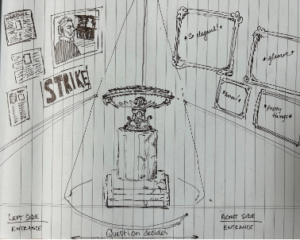By Abby Zepick
Many museums carry thousands of objects within their walls, and most of the time only a small fraction of those objects ever get to be looked upon by the everyday visitor. Exhibitors may feel the urge to put as many objects on display as possible to showcase the wide swath of materials available in the collection. However, the conversations we had in our Curatorial Practices class this week flipped that narrative on its head and asked the question: “What if we only highlighted one?”
Sometimes a single object can have as much of an impact on a visitor as a variety of objects meant to portray a central message. If the central message is the object, a unique story can be told. During our class time, we began by discussing how these single objects can offer a unique perspective based on the hands that they’ve passed through and the context they were drawn from. An example we discussed was a 2010 display of The Gross Clinic that featured objects and other paintings that helped heighten the painting and place it in a new context, following a major restoration project. After parsing the ins and outs of displaying a single object, it was time to put our ideas to the test.
The class was split into groups and assigned a chapter from Nancy Moses’s book Lost in the Museum: Buried Treasures and the Stories They Tell to read before class. During class, we applied the knowledge we gained from these objects and used them to design a single-object exhibition that highlights the stories that these objects tell. My group developed an idea for an exhibit that highlighted the Tibetan Refugee Crisis, featuring summer garments from a Tibetan Princess who fled to Seattle in the mid-20th century. Other groups designed displays that featured artwork, taxidermy birds, and even an ornate silver bowl with a complicated history.

A drawing of a proposed exhibition that features an ornate silver bowl given as a gift to Franklin B. Gowen for crushing the efforts of the Workingmen’s Benevolent Association.
Our exhibition proposals explored many different themes and ideas, and each took their own interpretation of the single-object exhibition. We can use these highlighted objects to tell stories about the people who owned them previously, the cultures and ideas they represent, the people who collected them, or their significance today. We can also display the object in question by itself or even feature other objects that may supplement the concepts being taught. Though the idea of a single object exhibition may seem limiting, there are worlds of possibilities to be explored.
At the end of class, we were introduced to another project we will be doing for the Museum of Broken Relationships: satellite displays. These displays of just 1-3 objects are meant to extend the exhibit at Herron Galleries into other sites around Indianapolis and IUPUI. Each of us will be assigned a location. These locations, which were revealed to us in class, include places like the Indianapolis Central Library, the Garfield Park Arts Center, and the IUPUI Campus Center. Each display will follow a theme, and it will be up to us to curate the object(s) for display.
While these displays might technically feature more than one object, we will be using the concepts discussed in class to guide our work.
Abigail Zepick is a second year Museum Studies master’s student at IUPUI’s School of Liberal Arts.
Works Cited:
Moses, Nancy. 2008. Lost in the Museum: Buried Treasures and the Stories they Tell. AltaMira Press.
Tucker, Mark. 2012. “Framing The Gross Clinic. Conservators and Exhibitions”. American Art, vol. 26, no 1, 10-13.

